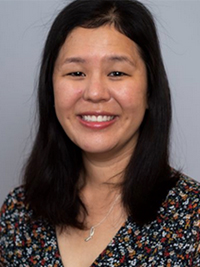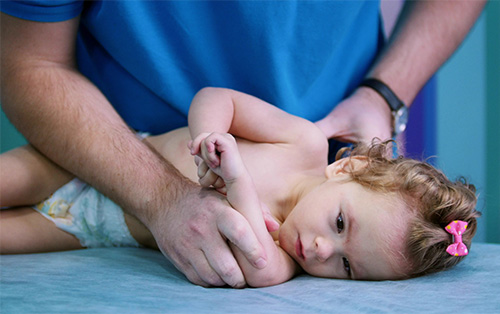Early Detection Initiative Identifies Newborns at Risk for Cerebral Palsy
Neonatologists Faith Kim, MD, and Sandhya Sitaraman Brachio, MD, faculty in the Division of Neonatology in the Department of Pediatrics at NewYork-Presbyterian/
“My interest has always been in following the neurodevelopmental outcomes in our high-risk babies and finding ways to improve their trajectories,” says Dr. Kim, who completed her neonatal-perinatal medicine fellowship at NewYork-Presbyterian Morgan Stanley Children’s Hospital in 2021 before staying on as faculty. Given her longstanding interest in this area, she was asked by Anna Penn, MD, PhD, Chief of Neonatology at Columbia, to spearhead the Cerebral Palsy Early Detection Initiative, which is supported by the Cerebral Palsy Foundation.
While CP can be caused by injury to the developing brain during pregnancy or surrounding birth, the etiology is still unknown in more than 50% of cases. Oftentimes diagnosis is delayed until a child is close to 2 years old but by this age, neuroplasticity is already decreasing and the opportunity may have been missed to intervene earlier when the potential for improving long-term outcomes is at its greatest. “The optimal timing of neuroplasticity is in those few months at the beginning of life,” says Dr. Kim. “This is the hypothesis behind the initiative. If we can detect CP earlier during this critical period of neuroplasticity and intervene, then hopefully we could optimize motor outcomes and prevent other complications as children develop. Historically, while clinicians might have suspected a diagnosis of CP early on, they delayed having the difficult conversation with parents until the diagnosis was more certain.”

Dr. Faith Kim
In 2020, the Cerebral Palsy Foundation reported on the results of its Early Detection and Intervention Network – the first collaborative endeavor comprising five diverse institutions with high-risk infant follow-up programs across the country. Utilizing international guidelines published in JAMA Pediatrics in 2017 by Dr. Iona Novak and colleagues, the network demonstrated – for the first time – that it was able to reduce the age of a CP diagnosis from 19.5 months to 9.5 months within one year of implementing the use of standardized tools. The results were published in the May 2020 issue of Pediatrics.
With these significant results, the Cerebral Palsy Foundation’s network continued to grow, and in 2021, Dr. Anna Penn was awarded a grant to implement its own early detection and intervention program – the Cerebral Palsy Early Detection and Intervention Initiative. “With this grant, we joined their network and have been able to collaborate with NICUs across the country that have already put this into practice for the past few years,” says Dr. Kim. “The foundation along with the incredible mentorship and guidance provided to us by Dr. Nathalie Maitre helped us to get the program underway. We were also able to bring on a nurse practitioner, Dr. Sylvan Ryder, who serves as Director of Operations for the GraD Clinic and is our early detection coordinator. In July 2021, Dr. Lisa Yoon who is a pediatric physical therapist joined our clinic in July 2021 and has a lot of experience working with this particular population. Several of our providers, including the physical and occupational therapists who work on the inpatient team, were trained in two assessment tools – the General Movement Assessment [GMA] and Hammersmith Infant Neurological Examination [HINE]. Previously, no standardized assessments were being utilized to screen for cerebral palsy in the NICU and GraD Clinic. These are validated and well-studied tools with a high predictive value for diagnosing cerebral palsy earlier in infants.”
General Movement Assessment
Distinct spontaneous general movements are typical in infants from before birth through to 20 weeks post-term. Infants who have “cramped synchronized” movements close to term-corrected age and/or demonstrate “absent fidgety” movements around 3-4 months of age are at higher risk of developing CP. The GMA is a non-invasive assessment that can be completed from birth to 20 weeks of age (corrected for prematurity) to identify neurological issues that may be related to cerebral palsy and other developmental disabilities.
“The GMA requires three- to five-minute video recordings of the baby in the NICU and in the GraD Clinic,” continues Dr. Kim. “We then review the video and observe the quality of the baby’s general movements looking for any evidence of cramped synchronized or absent fidgety movements, which have a high predictive value for developing CP. While the video recording is not diagnostic, it helps us identify higher-risk infants. This is helpful in our decision making to obtain more imaging like a brain MRI and provide better anticipatory guidance to families about the importance of Early Intervention and follow-up clinic.”
Hammersmith Infant Neurological Examination
The HINE is a simple standardized clinical neurological examination validated for infants between 2 and 24 months of age. It takes about 5 minutes to perform and requires minimal equipment. The exam has good sensitivity and high predictive value for risk of cerebral palsy in high-risk infants. “For example, a HINE score <57 at 3 months is 96 percent predictive of cerebral palsy and can be repeated over time to provide a better longitudinal trajectory” says Dr. Kim. “The HINE exam involves different components of a typical neurologic exam so most pediatricians would be very familiar with the basic elements evaluated such as the cranial nerves, the infant’s tone and posture, movements and reflexes.”
“The GMA, HINE, and neuroimaging together have the highest pooled predictive value for diagnosing cerebral palsy, which can even be made as early as three months’ corrected age in high-risk infants.” — Dr. Faith Kim
Transitioning to the GraD Clinic
The Columbia Neonatal Growth and Development (GraD) Clinic is an outpatient program providing comprehensive medical and developmental care for premature and medically complex infants and their families during the first three years of life. The team is comprised of neonatologists, a nurse practitioner, a developmental pediatrician, a physical therapist, a clinical psychologist, neonatal-perinatal fellows and a clinic coordinator. Providers perform a variety of developmental assessments such as the HINE, Alberta Infant Motor Scale, and Bayley Scales of infant and Toddler Development 4th edition at different time points and monitor other important areas of development such as feeding, behavior and sleep habits. They help connect families with Early Intervention if needed and provide overall developmental surveillance for the first years of life after discharge from the NICU.

Dr. Sandhya Brachio
“Our goal is to identify any developmental delays in infants as early as possible so that we can connect families with therapies and additional resources,” says Dr. Sandhya Brachio. “The developmental trajectory for any infant who has spent time in the NICU requires more scrutiny than for a child who was discharged home after birth. We have to account for prematurity, medical complexity and other factors that might impact development of their cognitive, motor, and language skills.
“Children who are born preterm or have evidence of neurologic injury are at higher risk for cerebral palsy. With the Cerebral Palsy Early Detection Initiative, we have put forth a comprehensive, detailed plan for evaluation. By standardizing our approach with specific assessment tools, we have been able to diagnose children with cerebral palsy much earlier and help families connect with therapeutic resources, such as hospital-based physical therapy, occupational therapy, and early intervention services, and support parents in becoming advocates for their children.
“Currently, interventions for infants diagnosed with CP include the earlier introduction of physical and occupational therapy for these babies. We are also working to address developmental care in the NICU to help with neuroprotection. As the medical director of the GraD Clinic, I’ve begun coordinating with other medical directors of NICU follow-up clinics in New York City, as well as regionally, to create a network that can work to optimize follow up and follow-through for patients discharged from the NICU. This forum has also been a space to raise awareness of the now standardized approach for early detection of CP made possible by the Cerebral Palsy Foundation’s initiative,” says Dr. Brachio.
“With the Cerebral Palsy Early Detection Initiative, we have put forth a comprehensive, detailed plan for evaluation. By standardizing our approach with specific assessment tools, we have been able to diagnose children much earlier and help families connect with therapeutic resources.” — Dr. Sandhya Brachio
According to Dr. Kim, a number of trials have demonstrated specifically, for example, that constraint induced movement therapy has been shown to be effective in young infants who have a hemiplegic cerebral palsy subtype resulting in better hand function when they’re a little bit older. “A recent study reported the positive effect of an early home-based intervention known as Goals-Activity-Motor Enrichment or GAME program involves key components like intensive motor training with the help of a physical therapist, education for parents and modifications to the home environment to enrich the learning environment,” notes Dr. Kim. “This approach was shown to lead to better cognitive and motor outcomes in infants when they’re about 12 months old and was well-accepted by families.”
“The GMA, HINE, and neuroimaging together have the highest pooled predictive value for diagnosing cerebral palsy, which can now be made as early as three months’ corrected age in high-risk infants,” says Dr. Kim. “Providing both early detection and future early intervention for cerebral palsy are the new accepted standard of care. Since we started this initiative in the summer of 2022, we were able to improve inpatient and outpatient screening at Columbia from a baseline of 0 percent to more 80 percent in less than 6 months of qualifying neonates by standardizing screening practices.”
The implementation of the Cerebral Palsy Early Detection Initiative at NewYork-Presbyterian/

A toddler with cerebral palsy having occupational therapy
The Cerebral Palsy Foundation grant has now been extended for two more years. “We are excited to continue this collaboration going forward with the Cerebral Palsy Foundation,” says Dr. Kim. “We will be working on refining our skillset and focusing on sustainability of this initiative while increasing awareness and education within and outside of the walls of our hospital and clinic. We also hope to learn more about the family’s perception of early diagnosis. Literature supports that families have a positive perception of early diagnosis because it allows them more time to start interventions like physical therapy earlier and hopefully improve their child’s outcomes, which is ultimately our shared goal.”
For More Information
Dr. Faith Kim
Dr. Sandhya Brachio
NewYork-Presbyterian
Advances in Pediatrics
Read more about our latest clinical advances.


